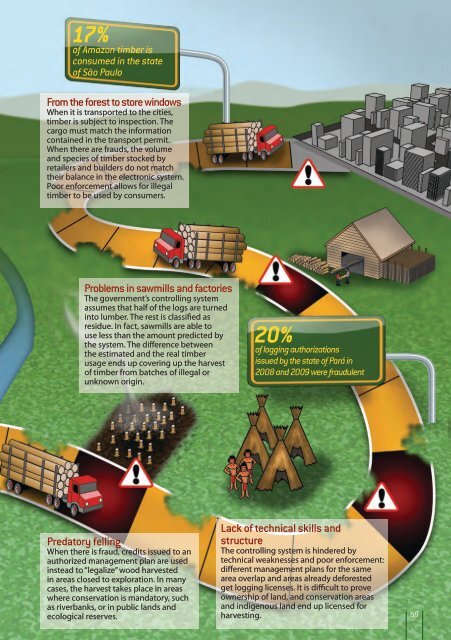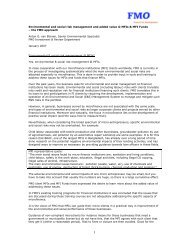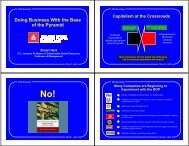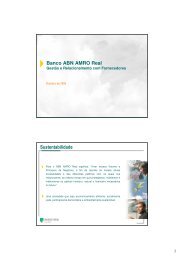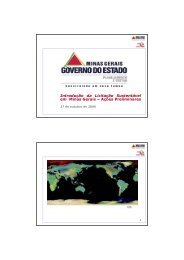From the forest to the consumer - GVces - Fundação Getulio Vargas
From the forest to the consumer - GVces - Fundação Getulio Vargas
From the forest to the consumer - GVces - Fundação Getulio Vargas
You also want an ePaper? Increase the reach of your titles
YUMPU automatically turns print PDFs into web optimized ePapers that Google loves.
17%<br />
of Amazon timber is<br />
consumed in <strong>the</strong> state<br />
of São Paulo<br />
<strong>From</strong> <strong>the</strong> <strong>forest</strong> <strong>to</strong> s<strong>to</strong>re windows<br />
When it is transported <strong>to</strong> <strong>the</strong> cities,<br />
timber is subject <strong>to</strong> inspection. The<br />
cargo must match <strong>the</strong> information<br />
contained in <strong>the</strong> transport permit.<br />
When <strong>the</strong>re are frauds, <strong>the</strong> volume<br />
and species of timber s<strong>to</strong>cked by<br />
retailers and builders do not match<br />
<strong>the</strong>ir balance in <strong>the</strong> electronic system.<br />
Poor enforcement allows for illegal<br />
timber <strong>to</strong> be used by <strong>consumer</strong>s.<br />
Problems in sawmills and fac<strong>to</strong>ries<br />
The government’s controlling system<br />
assumes that half of <strong>the</strong> logs are turned<br />
in<strong>to</strong> lumber. The rest is classified as<br />
residue. In fact, sawmills are able <strong>to</strong><br />
use less than <strong>the</strong> amount predicted by<br />
<strong>the</strong> system. The difference between<br />
<strong>the</strong> estimated and <strong>the</strong> real timber<br />
usage ends up covering up <strong>the</strong> harvest<br />
of timber from batches of illegal or<br />
unknown origin.<br />
Preda<strong>to</strong>ry felling<br />
When <strong>the</strong>re is fraud, credits issued <strong>to</strong> an<br />
authorized management plan are used<br />
instead <strong>to</strong> “legalize” wood harvested<br />
in areas closed <strong>to</strong> exploration. In many<br />
cases, <strong>the</strong> harvest takes place in areas<br />
where conservation is manda<strong>to</strong>ry, such<br />
as riverbanks, or in public lands and<br />
ecological reserves.<br />
20%<br />
of logging authorizations<br />
issued by <strong>the</strong> state of Pará in<br />
2008 and 2009 were fraudulent<br />
lack of technical skills and<br />
structure<br />
The controlling system is hindered by<br />
technical weaknesses and poor enforcement:<br />
different management plans for <strong>the</strong> same<br />
area overlap and areas already de<strong>forest</strong>ed<br />
get logging licenses. It is difficult <strong>to</strong> prove<br />
ownership of land, and conservation areas<br />
and indigenous land end up licensed for<br />
harvesting.<br />
69


